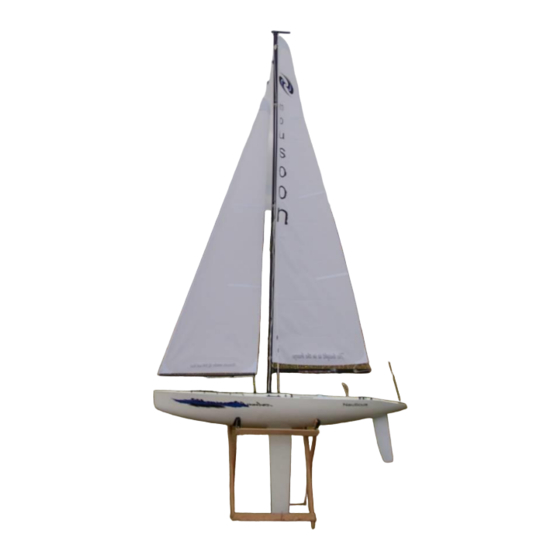
Advertisement
Quick Links
Advertisement

Subscribe to Our Youtube Channel
Summary of Contents for HobbyKing MONSOON
- Page 1 MONSOON INSTRUCTIONS A LMOST READY TO SAIL MODEL YACHT...
-
Page 2: Assemble The Stand
MODEL YACHT – ASSEMBLY INSTRUCTIONS & SAILING ASSEMBLE THE HULL, KEEL AND MASTER HINTS Thank you for purchasing one of our range of model sailing yachts, we hope it will bring you many hours of pleasure and relaxation. The instructions are aimed at making the assembly of the yacht a pleasurable and rewarding experience;... - Page 3 Cover this nut assembly with petroleum jelly and put the small The rudder should now be aligned with the centre line of the hull, black cover in place. once this is ok, put the sticker provided in place to cover and waterproof this rebate and rudder assembly.
- Page 4 ASSEMBLE THE MAST AND SAILS Now fit the mast cap or top hat ensuring the long arm is on the First join the 2 sections of the mast and fix with the 2mm black same side of the mast as the groove. screws provided.
- Page 5 Now it is time to stand the mast! Sit the base of the mast in the hole provided in the deck checking that the black mast base is in place. The mainsail boom should now be installed, this can be done by sliding the black plastic fitting on the end of the boom into the fitting on the mast and lining up the holes, then insert the small bolt and screw the nut onto the end being careful not to over tighten and...
- Page 6 Now clip on the rod (boom vang) that goes between the brass ball links at the base of the mast and on the mainsail boom. Then take the line at the top of the mainsail and thread it through the hole in the top hat, pull it quite tight and wind it around the turnbuckle just below.
- Page 7 ASSEMBLE THE WINCH LINES This yacht has a radio controlled proportional electric sail winch. Proportional means that as you push the left stick on the transmitter up and down the sails will go in and out in the same ratio. This will allow you (with some practice) to sail in all direction to the wind with the exception of directly into it.
- Page 8 READlNG THE WlND When you get to your favorite pond, take a few moments to observe wind direction, speed, and frequency of gusts and adjust your sailboat's rigging as necessary What follows are guidelines for tuning your ship's sails and rigging, but with experience you will gain the ability to fine-tune your sails and rigging for optimal performance, regardless of conditions.
-
Page 9: Getting Where You Need To Go
GETTING WHERE YOU NEED TO GO In any case, you basically want the sails to be full of air and just on Sailboats can easily sail downwind but sailing against the wind can the verge of luffing. Here are some other terms that describe be quite challenging. -
Page 10: Launch Procedure
·CAUTION: Windy conditions cause rough water that will affect the things like wind direction and size of the pond or lake when performance of your boat, and increase the chances of taking on surveying areas to run your sailboat. We recommend that you do water.














Need help?
Do you have a question about the MONSOON and is the answer not in the manual?
Questions and answers